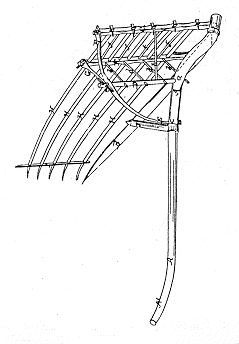Scythe
Scythe is a traditional agricultural hand tool, used for mowing grass or reaping crops. It has a long history, dating back to times before the advent of the agricultural machinery, and has played a significant role in the development of agriculture across various cultures. The scythe consists of a long, curved blade attached at an angle to a long handle, known as a snath, which allows the user to cut vegetation with a sweeping motion without the need to bend down.
History[edit | edit source]
The origins of the scythe are difficult to trace with precision, but it is believed to have been used in its basic form since ancient times. Early examples were likely made from wood, with a sharpened stone or metal blade. The tool evolved over centuries, with significant improvements made during the Middle Ages, when metalworking techniques allowed for the creation of more durable and effective blades. The scythe became a common tool in Europe, particularly for harvesting cereals, and its use spread to other parts of the world with European colonization.
Design and Use[edit | edit source]
A traditional scythe consists of a curved, steel blade, a wooden snath, and two handles called grips. The curvature of the blade varies according to the type of vegetation being cut and the preferences of the user. The snath is typically made to fit the height and arm length of the user, allowing for efficient and comfortable use.
Using a scythe requires a specific technique, involving a smooth, sweeping motion from the body. Proper use of the scythe is efficient and can cover large areas of land with minimal effort compared to hand-held sickles. However, mastering the scythe takes practice and skill, particularly in maintaining the correct blade angle and sharpness for effective cutting.
Cultural Significance[edit | edit source]
The scythe has not only been an important agricultural tool but also holds a place in various cultural and symbolic contexts. It is often associated with the figure of Death in Western culture, where Death is depicted as a skeletal figure carrying a large scythe, symbolizing the harvest of souls. This imagery has been prevalent in art, literature, and mythology, reflecting the tool's deep-rooted significance in human society.
Modern Use[edit | edit source]
With the advent of modern agricultural machinery, the use of the scythe has declined in many parts of the world. However, it remains in use in some rural areas and by small-scale farmers who prefer manual tools due to their low cost and environmental impact. Additionally, there has been a resurgence of interest in traditional farming tools and techniques, including scything, as part of the sustainable agriculture movement.
The scythe is also used in competitive events, such as scything competitions, where participants are judged on their efficiency and skill in cutting grass or crops. These events celebrate the skill and tradition associated with the scythe, keeping its use and cultural significance alive.
See Also[edit | edit source]
Search WikiMD
Ad.Tired of being Overweight? Try W8MD's physician weight loss program.
Semaglutide (Ozempic / Wegovy and Tirzepatide (Mounjaro / Zepbound) available.
Advertise on WikiMD
|
WikiMD's Wellness Encyclopedia |
| Let Food Be Thy Medicine Medicine Thy Food - Hippocrates |
Translate this page: - East Asian
中文,
日本,
한국어,
South Asian
हिन्दी,
தமிழ்,
తెలుగు,
Urdu,
ಕನ್ನಡ,
Southeast Asian
Indonesian,
Vietnamese,
Thai,
မြန်မာဘာသာ,
বাংলা
European
español,
Deutsch,
français,
Greek,
português do Brasil,
polski,
română,
русский,
Nederlands,
norsk,
svenska,
suomi,
Italian
Middle Eastern & African
عربى,
Turkish,
Persian,
Hebrew,
Afrikaans,
isiZulu,
Kiswahili,
Other
Bulgarian,
Hungarian,
Czech,
Swedish,
മലയാളം,
मराठी,
ਪੰਜਾਬੀ,
ગુજરાતી,
Portuguese,
Ukrainian
Medical Disclaimer: WikiMD is not a substitute for professional medical advice. The information on WikiMD is provided as an information resource only, may be incorrect, outdated or misleading, and is not to be used or relied on for any diagnostic or treatment purposes. Please consult your health care provider before making any healthcare decisions or for guidance about a specific medical condition. WikiMD expressly disclaims responsibility, and shall have no liability, for any damages, loss, injury, or liability whatsoever suffered as a result of your reliance on the information contained in this site. By visiting this site you agree to the foregoing terms and conditions, which may from time to time be changed or supplemented by WikiMD. If you do not agree to the foregoing terms and conditions, you should not enter or use this site. See full disclaimer.
Credits:Most images are courtesy of Wikimedia commons, and templates, categories Wikipedia, licensed under CC BY SA or similar.
Contributors: Prab R. Tumpati, MD






